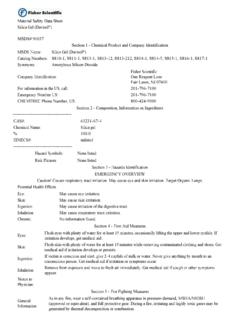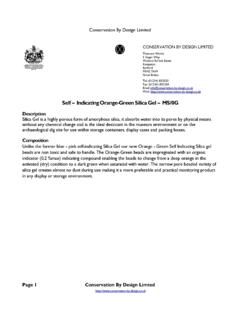Transcription of Synthesis and characterization of magnetic nanoparticles ...
1 420 Cer mica 55 (2009) 420-424 INTRODUCTIONC hemically synthesized magnetic nanoparticles have drawn much attention [1-3] due to the unique magnetic properties associated to their size magnitude and distribution uniformity. Among these particles, magnetite nanoparticles have been widely studied with biomedical applications in view, such as magnetic resonance imaging for clinical diagnosis, magnetic drug targeting, hyperthermia anti-cancer strategy, and enzyme immobilization [4-11].Magnetite (Fe3O4), a common magnetic iron oxide, has a cubic inverse spinel structure with oxygen forming a FCC closed packing and Fe cations occupying the interstitial tetrahedral and octahedral sites [12]. The electrons can hop between Fe2+ and Fe3+ ions in octahedral sites even at room temperature, rendering magnetite an important half-metallic material [13].
2 Due to the anisotropic dipolar attraction, unmodified magnetic nanoparticles of iron oxides tend to aggregate into large clusters and thus lose the specific properties associated with single-domain. In addition, the reactivity of iron oxide particles has been shown to increase greatly as their dimensions are reduced and they may undergo rapid biodegradation when exposed directly to biological systems [14, 15]. Suitable coating is essential to prevent such limitation [16]. silica coating of magnetic nanoparticles has become a promising and important approach in the development of magnetic nanoparticles for both fundamental study and technological research.
3 The formation of a silica coating on the surface of iron oxide nanoparticles could help prevent their aggregation in liquid and improve their chemical stability. Another advantage of silica -coating iron oxide nanoparticles is that the silanol-terminated surface groups may be modified with various coupling agents to covalently bind to specific ligands Synthesis and characterization of magnetic nanoparticles coated with silica through a sol-gel approach(S ntese e caracteriza o de nanopart culas magn ticas revestidas com s lica atrav s de um processo sol-gel)A. L. Andrade, D. M. Souza, M. C. Pereira, J. D. Fabris, R. Z. DominguesDepartamento de Qu mica, Universidade Federal de Minas Gerais, 702, Belo Horizonte, MG, paper investigates the influence of reaction medium pH on silica -coating of magnetite nanoparticles .
4 Magnetite nanoparticles were prepared by means of a reduction-precipitation method using ferric chloride as a starting material, which was partially reduced to ferrous salts by Na2SO3 before alkalinizing with ammonia. The particles were coated by sol-gel method with either ammonia or HCl aqueous solutions for either base- or acid-catalyzed hydrolysis, respectively. Powder X-ray diffraction, Fourier-transform infrared, and Zeta Potential were used for the characterization of oxides and of the coated magnetic nanoparticles . The observed difference of pHIEP in KCl solution for pure silica ( ), magnetite ( ), and silica -coated magnetite ( ) samples confirms that the coating process was effective since the charge surface properties of coated magnetic nanoparticles are close to that of pure silica , even though the Fourier-transform infrared spectra did not evidence the formation of Fe-O-Si : magnetite, coating, trabalho aborda a influ ncia do pH do meio de rea o, no procedimento de revestimento de nanopart culas magn ticas de magnetita, preparadas por redu o-precipita o de cloreto f rrico.
5 O material de partida foi parcialmente reduzido a sal ferroso, por rea o com Na2SO3, antes da alcaliniza o, com am nia. As part culas foram revestidas, pelo m todo sol-gel, a partir de solu o aquosa de am nia ou cido clor drico, para promover a hidr lise catalisada por base ou cido, respectivamente. Os materiais, de xidos de ferro e de nanopart culas magn ticas revestidas, assim produzidos, foram caracterizados por difra o de raios X, m todo do p , por infravermelho com transformada de Fourier e por potencial zeta para a determina o do pH do ponto isoel trico (pHIEP). A diferen a observada do pHIEP em solu o de KCl para amostras de s lica pura (2,0), magnetita (5,0) e para a magnetita revestida por s lica (2,3) confirma que o processo de revestimento foi efetivo, uma vez que as propriedades de carga de superf cie das nanopart culas magn ticas revestidas s o pr ximas s da s lica pura, apesar de o espectro de infravermelho com transformada de Fourier n o evidenciar padr es espectrais caracter sticos de liga es : magnetita, revestimento, nanopart L.
6 Andrade et al. / Cer mica 55 (2009) 420-424[17-19]. Finally, the most important is that the silica layer provides magnetic nanoparticles with a surface chemically friendly to biological various chemical Synthesis coating methods, the sol-gel process offers several advantages, including good homogeneity, low cost, and high purity. The electrical nature of the sample-water interface is the result of the hydrolysis of the surface species followed by pH-dependent dissociation of surface hydroxyls. A characteristic property of the sample surface is the condition of surface zero charge, known as zero point of charge (zpc), which is usually determined by some form of acid base titration technique.
7 Surface characteristics may also be investigated by electrokinetic phenomena, which involve the inter-relation between mechanical and electrical effects at a moving interface. Electrokinetic results are generally expressed in terms of zeta potential, which may be calculated from the electrophoretic mobility of particles through a field with known strength. The term, isoelectric point (iep) refers to conditions under which the zeta potential is zero. The surface potential need not be zero when the zeta potential is zero, particularly in the case of specifically adsorbed ions, hence the zpc and iep need not be the same [20]. In this work, zeta-potential measurements are used to monitor coating efficiency besides its characterization by X-ray diffraction (XRD), and Fourier-transform infrared grade FeCl3 6H2O and Na2SO3, ammonium hydroxide, ethyl alcohol, acetone, chloridric acid (Synth), and tetraethyl orthosilicate (TEOS -Aldrich 98%) were used as oxide nanoparticle synthesisThe method proposed in [21] was used in the preparation of nanoparticulate magnetite.
8 magnetic particles were synthesized using 15 mL (2 ) dissolved in HCl, 10 mL of Na2SO3 stock solution (1 ), and mL of ammonium hydroxide solution diluted to a total volume of 400 mL. The reaction was carried out in 1000-mL 3-necked round bottom flask by bubbling a protective gas (nitrogen) for ensure an inert atmosphere. Just after mixing Fe3+ and SO32-, the color of the solution changed from light yellow to red and afterwards back to yellow. At that moment, the diluted ammonia solution was poured into the solution quickly under vigorous stirring and a black precipitate was formed. The reaction was continued by stirring for an additional 30 min. The supernatant was discarded and the black precipitate was centrifuged with distilled water.
9 This procedure was repeated five times and then, the precipitate obtained was centrifuged with acetone and subsequently placed in a desiccator and dried at room temperature. Then, the sample was reduced in a Pyrex tube under H2 flowing at 50 for 2 h at increasing temperature from 20 to 250 C at a rate of 10 , which was held for a total heating period of 2 h. This sample was labeled of iron oxide nanoparticleSilica coating was carried out using modified reported methods [22, 23]. Deng e cols. prepared silica -coated magnetite nanoparticles using different types of alcohols, and various volume ratios of ethanol to water (VE/W). The feeding amount of catalyst and TEOS were also varied and the Synthesis products were carefully characterized.
10 In our study we used the optimized experimental conditions obtained in those studies. The formulations of each reaction were the same except for the type of catalyst. Typically g of magnetic powder was diluted with 160 mL ethyl alcohol. This dispersion was homogenized by ultrasonic vibration in water bath for 10 min. Finally, 40 mL water, 1 mL TEOS, and either 5 mL ammonia aqueous (pH 10) or 5 mL of acidified (HCl - pH ) aqueous solution were slowly added to this dispersion and stirred for 24 h. At this point, magnetic separation was made with the help of a permanent magnet and the magnetic powder collected alone was thoroughly washed with distilled water six times.














